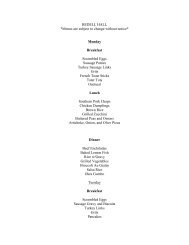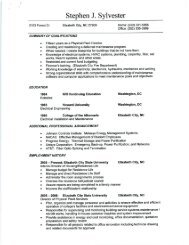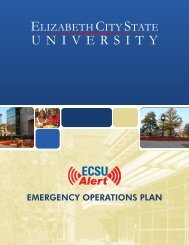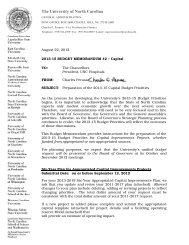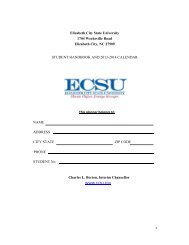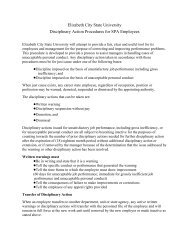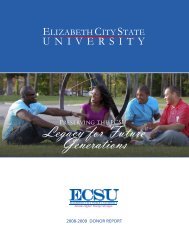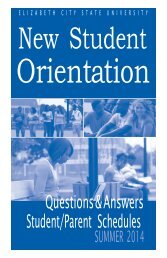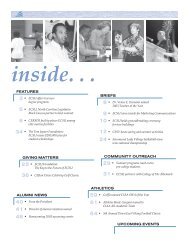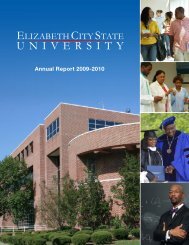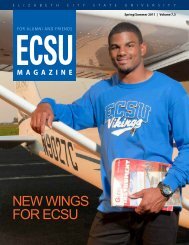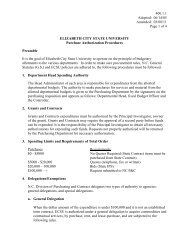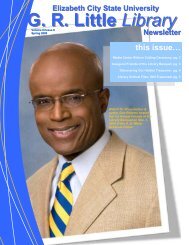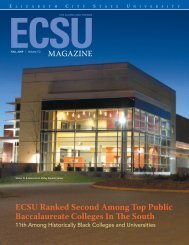Ronald E. McNair Postbaccalaureate Achievement Program
Ronald E. McNair Postbaccalaureate Achievement Program
Ronald E. McNair Postbaccalaureate Achievement Program
Create successful ePaper yourself
Turn your PDF publications into a flip-book with our unique Google optimized e-Paper software.
<strong>Ronald</strong> E. <strong>McNair</strong><br />
<strong>Postbaccalaureate</strong><br />
<strong>Achievement</strong> <strong>Program</strong><br />
<strong>McNair</strong> Scholars News & Journal 2011<br />
Volume 16
Table of Contents<br />
What is the <strong>Ronald</strong> E. <strong>McNair</strong> <strong>Postbaccalaureate</strong> <strong>Achievement</strong> <strong>Program</strong>.....................................................................1<br />
Who’s Who in the <strong>McNair</strong> Scholars <strong>Program</strong>.................................................................................................................................2<br />
Message from the Chancellor ...................................................................................................................................................................3<br />
Message from Principal Investigator/Director, <strong>McNair</strong> <strong>Program</strong>............................................................................................3<br />
Greetings from the Administrative Support Associate...............................................................................................................3<br />
2011 Research Abstracts .............................................................................................................................................................................4<br />
Differential Nitric Oxide Production by Human Cell Lines under Microgravity Conditions ........................4<br />
Effects of Anti-malarial Drugs (Sulfadoxine & Amodiaquine) on the Cytotoxicity Profile of Docetaxel<br />
against Prostate Cancer Cell Lines...................................................................................................................................................4<br />
Effects of Anti-malarial Drugs (Chloroquine and Pyrimethamine) on the Cytotoxicity Profile of<br />
Docetaxel against Prostate Cancer Cell Lines..........................................................................................................................4<br />
The Impact of Media Violence on Youth.......................................................................................................................................5<br />
Navigating <strong>Program</strong>med Mobile Robots Through a Maze.................................................................................................5<br />
Negative Externalities: Environment and Economic Impacts ..........................................................................................6<br />
Pros and Cons of Long-Term Care.................................................................................................................................................6<br />
The Role of African American Women in Black Churches................................................................................................6<br />
The Role of Novel Anti-cancer Compounds in Treating Breast Cancer and Prostate Cancer.....................7<br />
A Study of the Relationship between Substance Abuse and Recidivism Among<br />
Female Probationers................................................................................................................................................................................7<br />
Synthesis of 4’-Epimer of 2-fluoronoraristeromycin..............................................................................................................8<br />
Virtualization Technologies and its Applications in Green Data Center.....................................................................8<br />
Awards, Honors, and Recognitions ........................................................................................................................................................9<br />
Sixteenth Annual <strong>McNair</strong> Research Symposium & Awards Ceremony.....................................................................9<br />
2011 Cultural Enrichment Experiences, Interactive Workshops, Lecture Series, and Seminars .............10<br />
Dr. <strong>Ronald</strong> E. <strong>McNair</strong> Life History Center and Memorial Park.....................................................................................10<br />
University of South Carolina Graduate School and the Medical University of South<br />
Carolina Visitation ..................................................................................................................................................................................10<br />
Twenty-Fifth Annual <strong>Ronald</strong> E. <strong>McNair</strong> Commemorative Celebration and Tenth<br />
National Research Symposium.......................................................................................................................................................11<br />
University of Maryland-Baltimore County ...............................................................................................................................11<br />
Photo Gallery...................................................................................................................................................................................................12<br />
Alumni News...................................................................................................................................................................................................16
What is the <strong>Ronald</strong> E. <strong>McNair</strong><br />
<strong>Postbaccalaureate</strong> <strong>Achievement</strong> <strong>Program</strong><br />
The <strong>McNair</strong> <strong>Postbaccalaureate</strong> <strong>Achievement</strong> <strong>Program</strong> is named in honor<br />
of Dr. <strong>Ronald</strong> Erwin <strong>McNair</strong>, a renowned laser physicist and astronaut. Dr.<br />
<strong>McNair</strong>’s life was cut short due to a tragic accident aboard the USS<br />
Challenger space shuttle in January 1986. Dr. <strong>McNair</strong> graduated<br />
magna cum laude from North Carolina Agriculture and Technical<br />
State University in 1971 and received his Ph.D. at the age of 26<br />
from the Massachusetts Institute of Technology in 1976.<br />
After his death, members of Congress provided funding for the<br />
<strong>Ronald</strong> E. <strong>McNair</strong> <strong>Postbaccalaureate</strong> <strong>Achievement</strong> <strong>Program</strong> to<br />
encourage ethnic minorities, women and underrepresented<br />
groups to pursue graduate school opportunities, in particular<br />
doctoral studies. It is one of the six (6) federally funded TRIO<br />
programs, which provide direct services to low-income and/or<br />
first-generation college students. These programs are designed to<br />
help students overcome class, social, and cultural barriers to<br />
higher education.<br />
During the academic year of 1989-90, the <strong>Ronald</strong> E. <strong>McNair</strong><br />
<strong>Postbaccalaureate</strong> <strong>Achievement</strong> <strong>Program</strong> had its humble beginning with fourteen<br />
(14) projects. In the 2007 competition, the <strong>McNair</strong> program grew to 200 projects<br />
located in 42 of the 50 states (including the District of Columbia).<br />
How can ECSU’s <strong>McNair</strong> <strong>Postbaccalaureate</strong><br />
<strong>Achievement</strong> <strong>Program</strong> benefit its Participants<br />
<strong>Program</strong> participants at Elizabeth City State University receive exemplary supportive<br />
services that are designed to accomplish four (4) major goals: 1) to improve participant’s<br />
grade point averages, 2) to provide opportunities for research and other scholarly activities,<br />
3) to enhance the likelihood of admission to graduate programs of choice, and 4) to prepare<br />
students for “success” in graduate/doctoral studies.<br />
S e r v i c e s Ava i l a b l e<br />
• Academic Counseling<br />
• Access to the Internet and the World Wide Web<br />
• Career Development Workshops<br />
• Computer Assisted Instruction<br />
• Conference Travel/Field Trips/Graduate<br />
School Visitation<br />
• Financial Aid Assistance<br />
• Graduate School Placement<br />
• Intensive GRE Preparation Seminars<br />
• Mentorships<br />
• Research Training Colloquiums<br />
• Summer Internships/Research Opportunities<br />
• Stipend up to $2,800 (All eligible participants will<br />
receive a stipend of $2,000 plus $800 for room<br />
& board, if warranted.)<br />
• Visiting Lecturer Series<br />
• Tutoring<br />
h ow are mcnair scholars selected<br />
To be eligible for ECSU’s <strong>McNair</strong> <strong>Program</strong> one must be:<br />
• a United States citizen or permanent resident;<br />
• at least a second semester sophomore and enrolled at<br />
Elizabeth City State University;<br />
• in good academic standing with a GPA of 2.75 or better, and<br />
have a strong interest in attending graduate school;<br />
• a first generation college student with demonstrated<br />
financial need; or an ethnic minority (African Americans,<br />
Hispanic Americans, American Indians, Alaska Natives, Pacific<br />
Islanders, including native Hawaiians) and/or a member of a<br />
group who has been traditionally underrepresented at the<br />
doctoral degree level.<br />
<strong>McNair</strong> Scholars News & Journal 2011 / 1
<strong>Ronald</strong> E. <strong>McNair</strong> <strong>Postbaccalaureate</strong><br />
<strong>Achievement</strong> <strong>Program</strong><br />
Who’s Who in the <strong>McNair</strong> Scholars <strong>Program</strong><br />
a d m i n s t r at i v e sta f f<br />
Dr. Cheryl J. Lewis<br />
Principal Investigator/Director<br />
Mrs. Gwendolyn H. Cooper<br />
Administrative Support Associate<br />
Ms. Rena Moore<br />
Resident/Lab Assistant<br />
Mr. Dijon O. Perkins<br />
Resident/Lab Assistant<br />
f ac u l t y research mentors<br />
Dr. Dolapo Adedeji<br />
Dr. Hirendranath Banerjee<br />
Mr. Tommy Cox<br />
Dr. Moayed Daneshyari<br />
Dr. Brenda Norman<br />
Dr. Kingsley Nwala<br />
Dr. Innocent Ononiwu<br />
Dr. Ebere Oriaku<br />
Dr. Kuldeep Rawat<br />
Dr. Tesfaye Serbessa<br />
p o s t e r competition judges<br />
Dr. Gary Harmon<br />
Dr. Mohammad Hasan<br />
Dr. Jacqueline Huff<br />
Dr. Darnell Johnson<br />
Dr. Latasha Weeks<br />
o r a l competition judges<br />
Dr. Hilton Barrett<br />
Mr. Marque Debnam<br />
Mr. Orestes Gooden<br />
Dr. Deborah Riddick<br />
m c n a i r scholars<br />
(Summer Institute/internship)<br />
Husni Agri, Engineering Technology<br />
Lena Black, Biology<br />
Lakisha Campbell, Social Work<br />
Jonelle Brown, Business Administration<br />
LaDrea Cherry, Criminal Justice<br />
Alex Doyal, Computer Science<br />
Valerie Edwards, Aviation Science<br />
Gabrielle Green, Biology<br />
Tynesha Jackson, Chemistry<br />
Kristina Jiles, Biology<br />
Rakea Joyner, Criminal Justice<br />
DeVon <strong>McNair</strong>, Business Administration<br />
Monae Merck, History/English<br />
Taneshia Moore, Industrial Technology<br />
Tasha Palmer, Biology<br />
Jamie Peebles, Biology<br />
Stephanie Perez, Biology<br />
Alecia Riddick, Pharmaceutical Science<br />
Maya White, Biology<br />
m c n a i r scholars<br />
(Academic year only)<br />
LaTasha Bank, Business Administration<br />
Joshua L. Finney, Political Science<br />
James C. Irvin, Aviation Science<br />
Tomeika M. Jones, Political Science<br />
Susan Z. Mathews, Criminal Justice<br />
Akeem R. McAllister, Chemistry<br />
Camille S. McGowan, Psychology/English<br />
Triana McPherson, Chemistry<br />
LaVonde N. Roseboro, Biology<br />
2 / <strong>McNair</strong> Scholars News & Journal 2011
Message from the Chancellor<br />
Congratulations to all of the <strong>McNair</strong> Scholars program participants. I am extremely proud<br />
of your numerous accomplishments as well as your dedication to academic excellence.<br />
A special thanks to the faculty and staff who continue to support Elizabeth City State<br />
University and this signature program. The leadership of this university will continue<br />
to be a champion for academic innovation, scholarly activity, and high quality learning<br />
experiences for all students.<br />
Willie J. Gilchrist, Ed.D.<br />
Message from the Principal Investigator/<strong>McNair</strong><br />
Scholars <strong>Program</strong>s<br />
The <strong>Ronald</strong> E. <strong>McNair</strong> <strong>Postbaccalaureate</strong> <strong>Achievement</strong> <strong>Program</strong> proudly celebrates its<br />
seventeenth year on the campus of Elizabeth City State University. Sweet 16, how sweet<br />
the sound….but seventeen sound even better, as we continue to follow in the footsteps<br />
of Dr. <strong>Ronald</strong> Erwin <strong>McNair</strong> to promote excellence in teaching, research, and service.<br />
In doing so, we strive to train others to acknowledge that Excellence can be attained if<br />
you Care more than others think is wise, Strive for more than other think is possible,<br />
and be Upright and earnest in all that you say and do.<br />
Cheryl J. Lewis, Ed.D.<br />
ECSU <strong>McNair</strong> alum, current and future Scholars, faculty and staff, I wish you continual<br />
success for we know that you are a cut above the rest and you exemplify the better of<br />
the “best”.<br />
Greetings from the Administrative Support Associate<br />
Kudos <strong>McNair</strong> Scholars <strong>Program</strong>, as we celebrate another wonderful year at Elizabeth<br />
City State University. I am greatly appreciative of the opportunity that has been made<br />
available to me as the Administrative Support Associate of the <strong>McNair</strong> Scholars <strong>Program</strong>.<br />
It is a delight to work with students who have the desire, drive and determination to<br />
succeed in their education.<br />
My fondness for the <strong>McNair</strong> Scholars <strong>Program</strong> grows more with each passing year as I<br />
watch and participate in the matriculation of the students who are served. I commend<br />
and congratulate my Director, the <strong>McNair</strong> Scholars, the Faculty Research Mentors and<br />
the ECSU campus for their commitment, support, energy and passion.<br />
Mrs. Gwendolyn H. Cooper<br />
Administrative Support Associate<br />
<strong>McNair</strong> Scholars News & Journal 2011 / 3
2011 research abstracts<br />
Differential Nitric Oxide Production<br />
by Human Cell Lines under<br />
Microgravity Conditions<br />
Tynesha Jackson and Stephanie Perez, <strong>McNair</strong> Scholars<br />
Dr. Hirendranath Banerjee<br />
Department of Biology<br />
One of NASA’s major goals is to send a manned mission<br />
to Mars, which will expose astronauts to several months of<br />
microgravity conditions. Not much information is out there<br />
about effects of microgravity on human health. This research<br />
will study the effect of microgravity on human cells lines and<br />
record the expression of nitric oxide, which is a molecule<br />
released under stressful condition. The objective of this<br />
project is to simulate microgravity by exposing the cells to<br />
a NASA approved microgravity simulator/bioreactor and<br />
then measure the nitric oxide released by an ELISA reader/<br />
microplate reader or spectrophotometer in comparison to a<br />
non-exposed control cells.<br />
The remarkable Dr. <strong>Ronald</strong> E. <strong>McNair</strong> once said, “Truly there<br />
is no more beautiful sight than to see the earth from the<br />
space beyond”. For this reason, there are majestic men and<br />
women who embark on a voyage into the cosmos to further<br />
the research and knowledge of the scientific community. This<br />
research studied the levels of nitric oxide present in lymph<br />
sarcoma (immune) cells, breast cancer cells, and MRL (kidney)<br />
cells. Some may wonder why breast cancer cells The reason<br />
breast cancer cells were chosen would be because breast<br />
cancer affects both men and women. Although there are<br />
more male astronauts compared to females, it is a known<br />
fact that men are also capable of developing breast cancer.<br />
Consequently, the study of how breast cancer cells are affected<br />
by microgravity could provide valuable insight on whether<br />
microgravity has a positive or negative influence on the cells.<br />
If there was no available information regarding the fact that<br />
men could obtain breast cancer, the cell alone is a human cell<br />
that can assist in providing data regarding what happens to<br />
cells once they have been exposed to microgravity. This paper<br />
provides detailed knowledge on how microgravity affects the<br />
above cell lines, how the human body responds to microgravity,<br />
and the results found of the experiment conducted.<br />
Effects of Anti-malarial Drugs<br />
(Sulfadoxine & Amodiaquine) on<br />
the Cytotoxicity Profile of Docetaxel<br />
against Prostate Cancer Cell Lines<br />
Gabrielle Green and Maya White, <strong>McNair</strong> Scholars<br />
Dr. Dolapo Adedeji and Dr. Innocence Ononiwu<br />
Department of Pharmacy<br />
Prostate cancer is ranked the second highest most deadly<br />
diseases in men in the USA. Prostate cancer is cancer of the<br />
male reproductive gland, the prostate. There are various cell<br />
lines, which represent a different form of prostate cancer.<br />
Therefore, several different drugs along with an anticancer drug<br />
are used to treat them. The two drugs used were Sulfadoxine<br />
and Amodiaquine to try to cure prostate cancer. There are<br />
five different cell lines you can have PC-3, LNCaP, DU-145,<br />
CWR, and HS-5. The LNCaP cell line was established from<br />
a metastatic lesion of human prostatic adenocarcinoma. The<br />
LNCaP cells grow readily in vitro cells form clones in semisolid<br />
media, are highly resistant to human fibroblast interferon, and<br />
show an aneuploid human male karyotype with several marker<br />
chromosomes. PC3 (PC-3) and DU145 human prostate<br />
cancer cell lines are the “classical” cell lines of prostatic cancer.<br />
PC3 cells have high metastatic potential compared to DU145<br />
cells, which have a moderate metastatic potential.<br />
Effects of Anti-malarial Drugs<br />
(Chloroquine and Pyrimethamine) on<br />
the Cytotoxicity Profile of Docetaxel<br />
against Prostate Cancer Cell Lines<br />
Lena Black and Tasha Palmer, <strong>McNair</strong> Scholars<br />
Dr. Innocence Ononiwu<br />
Department of Pharmacy and Health Professions<br />
Many males in United States have suffered from prostate cancer<br />
for decades. Mitoxantrone and Docetaxel are currently the<br />
drugs used in hospitals to treat the disease. Other treatment<br />
options include surgical removal of the prostate and treatment<br />
with drugs that reduce the levels of circulating androgens.<br />
Some anti-malarial drugs have been reported to enhance<br />
4 / <strong>McNair</strong> Scholars News & Journal 2011
the efficacy of Docetaxel against other types of cancer. In the<br />
present study, the researchers evaluated the effects of two antimalarial<br />
drugs effects of Docetaxel on PC-3 human prostate<br />
cancer cell line. MTT anti-proliferative assay was used to assess<br />
the cancer cells viability in the presence of Docetaxel alone<br />
or Docetaxel plus each of the anti-malarial drugs. Docetaxel<br />
produced a dose-dependent inhibition of PC-3 cell lines with<br />
an IC50 value of ( 0.05-10µM) In the presence of increasing<br />
concentrations (0.1µM, 1.0µM and 10µM) of Chloroquine,<br />
the IC50 of Docetaxel on the prostate cancer cell line was<br />
observed to decrease (0.05-10µM respectively) in a dosedependent<br />
manner. Similarly, co-administration of increasing<br />
concentrations (0.1µM, 1.0µM and 10µM) of pyrimethamine<br />
produced decreasing IC50 values for Docetaxel (0.05-10µM<br />
respectively) on PC-3 human cancer cell lines. It is concluded<br />
that both anti-malarial drugs Chloroquine and pyrimethamine<br />
enhanced the cytotoxic effects of Docetaxel against PC-3<br />
prostate cancer cell line.<br />
The Impact of Media Violence on Youth<br />
Lakisha Campbell, <strong>McNair</strong> Scholar<br />
Dr. Brenda Norman<br />
Department of Criminal Justice, Sociology and Social Work<br />
The review of literature on television violence has increased<br />
tremendously during the past twenty years. However, during<br />
the 1990’s and today, new media has emerged which includes<br />
the Internet, Video Games, Cable Television, and Music Videos.<br />
These new types of Medias along with television have<br />
prompted public concerns and research attention. There has<br />
been growing concerns about the prevalence of violence in the<br />
media and its impact on youth in our society. Current research<br />
revealed that there is an association between youth exposure<br />
to media violence and their aggressive behaviors. Supported<br />
theories delineate how and why exposure to media violence<br />
increases aggression and violence in youth. A critical review<br />
of existing literature reveals that the impact of mass media<br />
violence on youth is an area that warrants special attention.<br />
Therefore, the purpose of this research project is to explore<br />
the impact of media violence on youth.<br />
Navigating <strong>Program</strong>med Mobile<br />
Robots Through a Maze<br />
Husni M. Agri and Valerie M. Edwards, <strong>McNair</strong> Scholars<br />
Dr. Moayed Daneshyari<br />
Department of Technology<br />
Robots are becoming increasingly popular in the 21st century.<br />
People have been incorporating them in different industries<br />
from space exploration, manufacturing, and even in their daily<br />
lives. The objective of this <strong>McNair</strong> summer research project<br />
is to assemble and program an iRobot Create to execute<br />
a series of tasks, where they may be applicable in different<br />
environments; as we know people use robots for human<br />
substitution in places where it may be dangerous for humans to<br />
maneuver. Some of these environments include extremely hot<br />
temperatures, bomb diffusions and nuclear reactors. There is a<br />
strong interest in personalized robots to do household duties<br />
as we are rapidly engaging in newer and more sophisticated<br />
technology. Some of these duties include security purposes,<br />
experimental activities, taking out the trash to vacuuming a<br />
floor. Therefore, the goal of this project is not only to program<br />
the robot, but also to modify it by incorporating real life useful<br />
functions and to serve as a platform for improving society.<br />
The first initial step when programming the iRobot Create<br />
was to download the appropriate software. The software<br />
that was utilized throughout daily research is called Realterm.<br />
Realterm is terminal software that allows communication from<br />
the computer to the robot. This program was used to send<br />
scripts and commands created for the robot to begin moving.<br />
Other applications such as C, C++, Open Interface Command<br />
Reference, etc., were commonly used in developing a true<br />
understanding of how to program the robot. There were<br />
also devices used as the robot was being programmed such<br />
as an arm and a camera that were attached to the robot for<br />
experimental purposes. In the end, the complete robot was<br />
capable of making 90-degree turns, picking up and handling<br />
different objects, and being able to correctly maneuver through<br />
a maze and find its destination.<br />
<strong>McNair</strong> Scholars News & Journal 2011 / 5
Negative Externalities:<br />
Environment and Economic Impacts<br />
DeVon <strong>McNair</strong>, <strong>McNair</strong> Scholar<br />
Dr. Kingsley Nwala<br />
Department of Accounting<br />
Negative Externality is an action of a producer that imposes<br />
negative side effects or costs on consumers without<br />
compensations. Negative externality generally results from<br />
the failure of our competitive market inflicting a cost to<br />
a third party not involved in the transactions without any<br />
compensation. Negative externalities can be of two types –<br />
Negative production externalities and Negative consumption<br />
externalities. Production externality may come from pollutants<br />
produced by Industrial production activities, which will result<br />
in air pollution, water pollution, toxic wastes, and solid wastes<br />
affecting both the environment and human health. These<br />
pollutants affect our waters, air quality, and plant growth and<br />
degrade our ecosystem. They also deplete our ozone layer,<br />
create global warming and other health related illnesses.<br />
Negative consumption externalities on the other hand<br />
can come from the consumption of certain products that<br />
consequently affect other consumers and society-at-large<br />
negatively. An example of this will be the impact of passive<br />
smoke from smokers in a restaurant to non-smokers in that<br />
same restaurant. The passive smoke eventually causes cancer<br />
and other health problems. Alcohol consumption and drug<br />
abuses are other examples. They inflict cost to the whole<br />
society, cause loss of workdays for the individual abusers, and<br />
decrease productivity in the economy. Other subsequent<br />
impacts include loss of wages, decrease in standard of life and<br />
consequent death or increase in mortality rate. It therefore<br />
becomes important and necessary that society understands the<br />
subject of Negative externalities, the causes, implications and<br />
consequences on our health, environment and the economy.<br />
Pros and Cons of Long-Term Care<br />
Jonelle K. Brown, <strong>McNair</strong> Scholar<br />
Dr. Ebere Oriaku<br />
Department of Business Administration<br />
Because of more effective medications, surgeries and<br />
application of medical technology, Americans are now living<br />
longer than before. This means that many of their health<br />
conditions decline as they age or as their disease progresses<br />
6 / <strong>McNair</strong> Scholars News & Journal 2011<br />
over a time and taking care of them becomes a burden for<br />
the government, their loved ones, and society-at-large. This<br />
research reviews the pros and cons of long-term care in<br />
America. The research also makes some recommendations<br />
as to what is a better solution to citizens who require longterm<br />
care. The research takes the position that long-term<br />
care administered to the chronically ill and elderly, provided at<br />
the their home in the form of home health care and respite<br />
care can result to a longer life span than the chronically ill<br />
and elderly kept in a public care location. The research has<br />
shown that the use of home health care can be more cost<br />
effective in the long run for the government, and will benefit<br />
society-at-large. The chronically ill and elderly in this study<br />
comprised of all elderly patients who were using home health<br />
care provisions and those placed in public health care facilities.<br />
Primary and secondary data was collected and analyzed to<br />
provide recommendations that supported the position of this<br />
research project.<br />
The Role of African American<br />
Women in Black Churches<br />
Monae Merck, <strong>McNair</strong> Scholar<br />
Dr. Brenda Norman<br />
Department of Criminal Justice, Sociology and Social Work<br />
The role of the black woman in the church varied from one<br />
religious denomination to another. While women as often<br />
referred to as “mother,” and highly respected in the religious<br />
and secular black community, they did not always hold<br />
positions of official power (Wolk, 2008). Often, they served as<br />
Evangelists, Missionaries, Teachers, and Choir Directors. If they<br />
did preach, it was without ordination, and often solely carried<br />
out the work of a deceased husband. As the church served as<br />
the center of the African American community, many women<br />
actively pursued leadership roles (Cox Gillespie, 2009). These<br />
roles and the degree of leadership available to them varied<br />
according to the time period and the religious denominations.<br />
Their fight for equality in areas such as preaching continues<br />
today. The roles of African American women in black churches<br />
have high values and expectations with new initiatives and<br />
expanded opportunities. Carpenter (2001) concluded that the<br />
appropriate roles of African American women in the church<br />
today would greatly influence the thinking of future ministers.<br />
Therefore, the purpose of this research project is to explore<br />
the roles of African American Women in black churches.
The Role of Novel Anti-cancer<br />
Compounds in Treating Breast<br />
Cancer and Prostate Cancer<br />
Jamie Peebles and Kristina Jiles, <strong>McNair</strong> Scholars<br />
Dr. Hirendranath Banerjee<br />
Department of Biology<br />
Cancer is a major curse on human health and a major killer<br />
around the world. Even today, very few effective anti-cancer<br />
drugs have been discovered. In this current study, the efficacy<br />
of certain novel inorganic synthetic drugs on human prostate<br />
and breast cancer was tested. Rhenium compounds are<br />
radioactive and are used for treatment in liver cancer. Very little<br />
is known about the toxicity of rhenium and its compounds<br />
because they are used in very small amounts. For years, the<br />
design of new metal-based drugs has concentrated on direct<br />
cisplatin analogues. Despite the synthesis and screening of<br />
different platinum drugs, no wide spectrum platinum drugs<br />
that overcame the drawbacks of cisplatin (the most successful<br />
transition metal drug currently available on the market) and<br />
its analogues were found. Thus, this problem causes a need<br />
for the development of new non-platinum-based metal<br />
drugs, which include gold, ruthenium, rhodium, and titanium<br />
complexes. Unfortunately, these drugs have adverse effects.<br />
Therefore, it is essential to synthesize drugs with less toxicity<br />
and high anticancer properties.<br />
Recently anti-cancer properties of six different Rhenium<br />
compounds were investigated for necrotic efficacy. After<br />
performing three 24-hour exposure trials of the drugs<br />
effect on the cancerous cells, they were compared, graphed,<br />
and a standard deviation was obtained. There were also<br />
48 and 72-hour exposure times for which only one trial<br />
was performed for each. The results show that drugs 3,<br />
4, and 5 had the greatest (average) effect on the viability<br />
of the cancerous cells. Anticancer properties of different<br />
Rhenium compounds were investigated for necrotic efficacy<br />
( (CO)3(Bipy)ReOC(O)OC5H11, (CO)3(5-Me)ReOC(O)<br />
OC5H11, (CO)3(Phen)ReOC(O)C5H11, (CO3)(2,9-Me2)<br />
ReOC(O)OC5H11, (CO)3(5,6-Me2)ReOC(O)OC5H11,<br />
(CO3O(Bathophen)ReOC(O)C5H11). After performing<br />
three 24-hour exposure trials of the drugs effect on the<br />
cancerous cells, they were compared, graphed, and a standard<br />
deviation was obtained. There were also 48 and 72-hour<br />
exposure times for which only one trial was performed for<br />
each due to certain time constraints.<br />
Six Rhenium drug compounds were used during this<br />
experiment. Breast and prostate cancer cell lines were cultured<br />
for at least twenty-four hours, incubated with the novel<br />
synthetic inorganic compounds (rhenium compounds), and<br />
Trypan Blue Staining, is used to determine the number of viable<br />
cells present in a cell suspension. It is based on the principle that<br />
live cells possess intact cell membranes that exclude certain<br />
dyes, such as Trypan blue, eosin, or propidium, whereas dead<br />
cells do not. Viable cells will have a clear cytoplasm whereas<br />
a nonviable cell will have a blue cytoplasm. A cell counter<br />
was used in order to obtain the amount of viable cells and a<br />
calculation of the statistical analysis of the data.<br />
A Study of the Relationship between<br />
Substance Abuse and Recidivism<br />
Among Female Probationers<br />
LaDrea Cherry and Rakea Joyner, <strong>McNair</strong> Scholars<br />
Mr. Tommy Cox<br />
Department of Criminology, Sociology and Social Work<br />
This paper explores articles that report on results from<br />
research conducted on the Relationship between Substance<br />
Abuse and Recidivism among female probation offenders.<br />
Typically, women entering treatment are younger, have less<br />
extensive criminal past, are less likely to be employed, have<br />
more financial and medical problems, and report greater<br />
depression, anxiety, and other psychological distress (e.g.,<br />
Chatham et.al. 1999). This study examined the relationship<br />
between female probationer offenders and recidivism. The<br />
studies were based on probationers that participated in<br />
residential drug treatment programs and how effective the<br />
treatment programs were. This research also sought to uncover<br />
the different methods of treatment that can be more useful<br />
to females within the criminal justice system and put more<br />
emphasis on the needs of women who have been incarcerated<br />
due to a drug offense. Furthermore, through this study, it is<br />
anticipated that there is clearly a need for more programs that<br />
cater specifically to the needs of female offenders (“Women<br />
in the criminal justice system”, 2007). Finally, this research will<br />
explore the effectiveness of these different programs and the<br />
outcome they have on the recidivism among the offenders.<br />
Overall, this study is designed to identify the connection<br />
between substance abuse treatment and the effectiveness it<br />
has on recidivism among female offenders.<br />
<strong>McNair</strong> Scholars News & Journal 2011 / 7
Synthesis of 4’-Epimer of<br />
2-fluoronoraristeromycin<br />
Alecia Riddick,<strong>McNair</strong> Scholar<br />
Dr. Tesfaye Serbessa<br />
Department of Chemistry, Geology, and Physics<br />
Biological methylation is an essential reaction that involves a<br />
wide spectrum of cellular processes such as DNA replication,<br />
methionine metabolism, polyamine and phospholipid<br />
biosynthesis, and quorum sensing. The relative cellular<br />
concentrations of the source of the methyl group, S-adenosyl-<br />
L-methionine (SAM), and the by-product of the reaction,<br />
S-adenosyl-L-homocysteine (SAH) are maintained by a<br />
hydrolytic enzyme. This enzyme, S-adenosyl-L-homocysteine<br />
hydrolase (SAHH), because of its central role in metabolism,<br />
has emerged as an attractive target in the design of therapeutic<br />
agents against a wide range of diseases. The recent discovery<br />
that the causative agent of malaria (plasmodium falciparum)<br />
has a parasite-specific hydrolase and the subsequent<br />
determination of the crystal structure is critical in the design<br />
and synthesis of compounds that will selectively inhibit the<br />
pathogen-specific hydrolase.<br />
fit the environment of a larger workplace. This virtualized<br />
infrastructure was created using VMWARE hypervisor ESXi<br />
4.0. The hardware platform used was a HP Blade workstation<br />
that consists of quad CPUs, 8 GB memory and 144 GB storage<br />
space. A pool of virtual machines (VMs) form computing<br />
resources that user can access anytime, anywhere and on any<br />
computing device via an Internet connection. These VMs were<br />
created to form computing resources and managed remotely<br />
through VMWARE VI Client interface. Each VM was created by<br />
allocating a certain amount of CPU cycle, memory, and virtual<br />
disk storage space. Each VM hosts an operating system and<br />
a set of computation-intensive engineering application tools<br />
such as MULTISIM, Packet Tracer, and SolidWorks. Tests were<br />
conducted to evaluate the performance of these VMs under<br />
various load conditions. Energy calculations were also done<br />
to compare the efficiency of virtualized infrastructure against<br />
deploying physical desktops in a laboratory set up. The project<br />
motivation, design, implementation, and performance testing<br />
results are discussed in this study.<br />
Carbocyclic nucleosides, analogs of the traditional nucleosides<br />
in which the oxygen of the ribofunose ring has been replaced<br />
by a methylene group, have shown significant inhibitory activity<br />
against hydrolases. In this project, in an effort to search for<br />
more potent and selective analogues against plasmodium<br />
falciparum, the 4’-Epimer of 2-fluoronoraristeromycin was<br />
synthesized. The synthesis of the target compound was<br />
achieved in 10 steps from commercially available starting<br />
materials.<br />
Virtualization Technologies and its<br />
Applications in Green Data Center<br />
Alex M. Doyal and Taneshia P. Moore, <strong>McNair</strong> Scholars<br />
Dr. Kuldeep S. Rawat<br />
Department of Technology<br />
The objective of this project was to demonstrate how<br />
virtualization technologies present a solution that can help<br />
achieve energy efficient (green) data centers. A virtualized<br />
infrastructure prototype was designed and created for a<br />
reliable and secure computing that can be easily scaled to<br />
8 / <strong>McNair</strong> Scholars News & Journal 2011
awards, honors & recognitions<br />
Rena Moore<br />
Wanda-Marie Carey<br />
and Dr. Cheryl J. Lewis<br />
Tasha Johnson<br />
Dalan Morring<br />
Honors were bestowed on a number<br />
of <strong>McNair</strong> Scholars at the Honors<br />
Convocation: The Road to Success!” on<br />
Thursday, April 7, 2011. Following the<br />
convocation, a photo opportunity and<br />
reception was held for <strong>McNair</strong> honorees<br />
in the Fine Art Center’s Art Studio.<br />
Ms. Rena Moore, a senior who is majoring<br />
in Criminal Justice was the recipient of<br />
the Chancellor’s Distinguished Emblem<br />
Award. For this special honor, she<br />
received a Scholars’ Blazers. Ms. Moore<br />
was also awarded the Criminal Justice<br />
Outstanding Academic <strong>Achievement</strong><br />
Award, Educational Talent Search<br />
Academic Excellence Award and the<br />
Excellence without Excuse Award from<br />
the <strong>Ronald</strong> E. <strong>McNair</strong> <strong>Postbaccalaureate</strong><br />
<strong>Achievement</strong> <strong>Program</strong>. Other recipients<br />
of this prestige award were Wanda-<br />
Marie Carey and Matthew Competiello.<br />
Rena, Wanda-Marie and Matthew<br />
Competiello, each earned a grade point<br />
average of 4.0 on a 4.0 grading scale<br />
for fall 2010. Mr. Competiello also was<br />
awarded the Outstanding Academic<br />
Award for having the highest GPA in<br />
the Department of History and Political<br />
Science and Mr. Christopher Kidd<br />
received the Naginder Dhillon Research<br />
Award in Political Science. Others<br />
whom received Department awards<br />
were Ms. Brittnee Exum (Language,<br />
Literature & Communication), Tasha<br />
Johnson (Criminal Justice), Camille<br />
McGowan (Psychology) and Dalan<br />
Morring (Business Administration, and<br />
Karen Wilkerson (Sociology).<br />
Three <strong>McNair</strong> graduating seniors<br />
received the Challenger Award for<br />
having GPAs of 3.50 or greater and an<br />
additional three were the beneficiary of the Eagle Award for<br />
possessing a GPA of 3.0 to 3.49. These awards went to Ms.<br />
LaShanda Dukes, Ms. Brittnee Exum (and the E. M. Spellman<br />
Award), Mrs. Karen Wilkerson (Challenger Award) and Ms.<br />
Lamonica Harrison, Mr. Christopher Krauss, Mr. Daniel Long<br />
and Mr. Robert Mason (Eagle Award).<br />
The awardees of the 2010-2011 Certificate of Merit Honors<br />
<strong>Program</strong> were Ms. Valerie Edwards, Ms. Gabrielle Green, Ms.<br />
Kristina Jiles, Ms. Jalisa Pettis and Ms. LaVonde Roseboro.<br />
Ms. Brittnee Shaneece Exum, Ms. Tiffany Mone’t Gates,<br />
Ms. Damika LaShun Howard, Ms. Kristina Ashleigh Jiles,<br />
Ms. Stephanie Perez, Ms. LaVonde Necole Roseboro was<br />
inducted into the Who’s Who Among Students in American<br />
Universities and Colleges.<br />
Sixteenth Annual <strong>McNair</strong> Research<br />
Symposium & Awards Ceremony<br />
On Friday, June 24, 2011, the <strong>Ronald</strong> E. <strong>McNair</strong><br />
<strong>Postbaccalaureate</strong> <strong>Achievement</strong> program hosted it 16th<br />
Annual Research Symposium and Awards Ceremony. Dr.<br />
Nathaniel Williams was the keynote speaker.<br />
Since 1993, Dr. Williams has<br />
been the President and CEO of<br />
HumanWorks Affiliates, Inc., a<br />
cluster of nine corporations that,<br />
focuses on human services.<br />
Dr. Williams’ journey from orphan<br />
and foster child to Doctor of<br />
Education, nonprofit founder, and<br />
author has been both challenging<br />
Dr. Nathaniel Williams and rewarding. Dr. Williams has<br />
proven that success can be attained when a person possesses<br />
commitment, tenacity, and integrity. In his career, he has<br />
fulfilled a multitude of roles, including direct care worker,<br />
foster parent, house parent, entrepreneur, nonprofit and forprofit<br />
organization founder, Chief Executive Officer, adjunct<br />
professor, scholar-in-residence, talk show host, international<br />
motivational speaker and author of nine books.<br />
<strong>McNair</strong> Scholars News & Journal 2011 / 9
This Research Symposium & Annual Awards Ceremony<br />
was multi-faceted, in that it served as a forum for reflection,<br />
celebration and appreciation. The program reflected upon<br />
the various challenges of 2011, as well as celebrated its<br />
accomplishments and blessings received during this same<br />
timeframe. This event also served as a way to say “thank<br />
you” to those who have supported the <strong>Ronald</strong> E. <strong>McNair</strong><br />
<strong>Postbaccalaureate</strong> <strong>Achievement</strong> <strong>Program</strong> in its endeavor<br />
to empower <strong>McNair</strong> Scholars to do common things in an<br />
uncommon way so that they can command the attention of<br />
the world.<br />
This year’s first place winner of the 2011 poster competition<br />
was Alecia Riddick (Dr. Tesfaye Serbessa, Faculty Research<br />
Mentor) in the poster competition. Ms. Riddick’s research topic<br />
was entitled, Synthesis of 4’-Epimer of 2-fluoronoraristeromycin.<br />
Other Poster Competition winners consisted of the 2nd place<br />
winner, DeVon <strong>McNair</strong> (Dr. Kingsley Nwala, Faculty Research<br />
Mentor), Ms. Tynesha Jackson & Ms. Stephanie Perez, (Dr.<br />
Hirendranath Banerjee, Faculty Research Mentor) placed<br />
third, and Mr. Husni Agri and Ms. Valerie Edwards (Dr. Moayed<br />
Daneshyari, Faculty Research Mentor) received honorable<br />
mention.<br />
The first place winners of the Oral Competition were Mr.<br />
Husni Agri and Ms. Valerie Edwards (Dr. Moayed Daneshyari,<br />
Faculty Research Mentor). Their research and demonstration<br />
consisted of Navigating <strong>Program</strong>med Mobile Robots Through<br />
a Maze. Others who placed in the Oral Competition were<br />
Ms. Kristina Jiles and Ms. Jamie Peebles (Dr. Hirendranath<br />
Banerjee, Faculty Research Mentor) for 2nd place, 3rd place<br />
was Ms. LaDrea Cherry and Ms. Rakea Joyner (Mr. Tommy Cox,<br />
Faculty Research Mentor) and Ms. Gabrielle Green and Ms.<br />
Maya White (Dr. Dolapo Adedeji and Dr. Innocence Ononiwu,<br />
Faculty Research Mentors) received honorable mention.<br />
to visit this historical site. Back in 1989, the <strong>Ronald</strong> <strong>McNair</strong><br />
Committee, the City of Lake City and the Lake City Library<br />
Board served as the official planning board for the Dr. <strong>McNair</strong><br />
Memorial Park. This park has been constructed in three<br />
phrases, which includes the building of the monument with<br />
a scroll of honor (completed in 1994), a bronze statue of Dr.<br />
<strong>McNair</strong> (erected in 1995) and the relocation of the tomb of<br />
<strong>McNair</strong> (2004) and a Life History Center (formerly known<br />
as the Lake City Library) has been created to pay homage to<br />
Dr. <strong>McNair</strong>. The ultimate plan is to create a Space Museum<br />
and Learning Center, at this site.<br />
Is it not ironic, that the Lake City Library has been transformed<br />
into <strong>McNair</strong>’s Life History Center This library is the same library<br />
that denied the 9 yr. old (<strong>Ronald</strong> <strong>McNair</strong>) borrowing privileges of<br />
an advanced science and calculus book. After calling the police,<br />
<strong>McNair</strong>’s mom, coupled with some persuasive dialog from his<br />
mother (a public school teacher), the librarian finally released<br />
the library books to him.<br />
<strong>McNair</strong> Life and History Center<br />
2011 Cultural Enrichment<br />
Experiences, Interactive Workshops,<br />
Lecture Series, and Seminars<br />
Dr. <strong>Ronald</strong> E. <strong>McNair</strong> Life History Center and<br />
Memorial Park<br />
What an historical moment, when Scholars and <strong>McNair</strong> Staff<br />
travelled to Lake City, South Carolina, the home of Dr. <strong>Ronald</strong><br />
E. <strong>McNair</strong>. ECSU <strong>McNair</strong> Scholars <strong>Program</strong> is the very first<br />
10 / <strong>McNair</strong> Scholars News & Journal 2011<br />
ECSU <strong>McNair</strong> <strong>Program</strong><br />
met with the <strong>Ronald</strong><br />
<strong>McNair</strong> Committee<br />
Dr. <strong>McNair</strong><br />
Memorial Park
University of South Carolina Graduate School and the<br />
Medical University of South Carolina Visitation<br />
The <strong>McNair</strong> <strong>Program</strong> in Elizabeth City, NC and the University of<br />
South Carolina-Columbia sponsored a meet and greet session on<br />
May 27, 2011. Scholars, faculty and staff shared their perceptions<br />
of the <strong>McNair</strong> experience and the many attributes, which it brings<br />
to the Academy.<br />
On Saturday, May 28, 2011, Mrs. Marshelle Grant, Manager of<br />
Recruitment and Diversity Education on the Medical University of<br />
South Carolina (MUSC), which is located in Charleston, SC, provided<br />
an extensive tour of their facilities. ECSU’s <strong>McNair</strong> staff & students<br />
met with MUSC medical students, faculty and staff, was provided a<br />
demonstration from Dr. Bryan Ziegler, Assistant Dean and Assistant<br />
Professor, Medical School.<br />
Drs. Cooper, Beasley, Lewis and USC <strong>McNair</strong> Staff<br />
USC and MUSC both provided extraordinary hospitality to our<br />
group. Before leaving beautiful historic Charleston, South Carolina,<br />
the group enjoyed the afternoon on a bus tour narrated by Alphonso<br />
Brown from Gullah Tours and an hour and 30 minutes cruising past<br />
Charleston’s famous Waterfront Park, the Cooper River Bridge,<br />
Patriots Point, Fort Sumter, Fort Moultrie and busy seaport.<br />
Twenty-Fifth Annual <strong>Ronald</strong> E. <strong>McNair</strong> Commemorative<br />
Celebration and Tenth National Research Symposium<br />
Medical University of South Carolina Tour<br />
Robert Mason<br />
During January 26-28, 2011, NC A & T University celebrated its 25th<br />
Annual <strong>Ronald</strong> E. <strong>McNair</strong> Commemorative Celebration and Tenth<br />
National Research Symposium. From Elizabeth City State University,<br />
we had Dr. Cheryl J. Lewis, Mrs. Gwendolyn H. Cooper, Mrs. Karen<br />
Wilkerson, Ms. Rena J. Moore, Ms. Lamonica Harrison, Mr. Husni<br />
Agri, Mr. Daniel Long III and Mr. Robert Mason to participate in the<br />
festivities. Mr. Mason also presented his 2010 research project at<br />
the National Research Symposium.<br />
Cruising Charleston’s Seaport and viewing Fort Sumter & Fort<br />
Moultrie, Front row: Devon <strong>McNair</strong> and Lakisha Campbell, Second<br />
row: Husni Agri, Rakea Jordan (hidden) and Jonelle Brown, Back Row:<br />
Monae Merck and other <strong>McNair</strong> Scholars<br />
<strong>McNair</strong> Scholars were also afforded the opportunity to tour the<br />
International Civil Rights Center & Museum housed in the old F. W.<br />
Woolworth Building located in Greensboro, NC, where four NCA<br />
& T students started a sit-in on February 1, 1960.<br />
A memorial service was held whereby Dr. <strong>McNair</strong>’s fraternity<br />
brothers (Omega Psi Phi) led the march to the <strong>Ronald</strong> E. <strong>McNair</strong><br />
Science Building. A series of presentations was presented on life and<br />
times of Dr. <strong>Ronald</strong> E. <strong>McNair</strong>.<br />
Omega Psi Phi Fraternity, Inc.<br />
University of Maryland-Baltimore County<br />
As first place winners of the 2011 <strong>McNair</strong> Scholars’ Oral Competition,<br />
Husni Agri and Valerie Edwards presented their research project at<br />
the University of Maryland-Baltimore County, an honors University<br />
lead by Dr. Freeman A. Hrabowski, III.<br />
Husni & Valerie at UMBC’s Career Fair and with their awards.<br />
<strong>McNair</strong> Scholars News & Journal 2011 / 11
12 / <strong>McNair</strong> Scholars News & Journal 2011<br />
photo gallery
photo gallery<br />
<strong>McNair</strong> Scholars News & Journal 2011 / 13
14 / <strong>McNair</strong> Scholars News & Journal 2011<br />
photo gallery
photo gallery<br />
<strong>McNair</strong> Scholars News & Journal 2011 / 15
alumni news<br />
2010-2011 bachelor degree recipients<br />
Ashley Berryman<br />
Wanda-Marie Carey<br />
Matthew Competiello<br />
Justin Deloatch<br />
Lashanda M. Dukes<br />
Brittnee Exum<br />
Lamonica S. Harrison<br />
Damika Howard<br />
Christopher Kidd<br />
Daniel Long<br />
Robert Mason<br />
Rena Moore<br />
Jametta N. Morgan<br />
Dalan Morring<br />
Jamila C. Peele<br />
Zina C. Penn<br />
Jalisa Pettis<br />
Barry Seebo<br />
Bryan Whidbee<br />
Ada White<br />
Shalanda Williams<br />
2010-2011 masters degree recipients<br />
Quiana Abner<br />
Tanya Chesson Blackshear<br />
Natasha Cox<br />
Shanitria N. Cutherbertson<br />
Tierra Harrington<br />
Essie R. Hedgebeth<br />
Sherice M. Jernigan<br />
Joseph R. Moore<br />
Lashonda Munden<br />
Lakisha Mundon Johnson<br />
Levi Peebles<br />
Richelle Smallwood<br />
Cusarah Thorpe<br />
Timeka Whitehead<br />
Tracsa Williams<br />
accepted and/or enrolled<br />
in a doctorate degree program<br />
Charlotte E. Chrisp<br />
Natasha Cox<br />
accepted and/or enrolled<br />
in a masters program<br />
Lashanda M. Dukes<br />
Brittnee Exum<br />
Quinatona Ford<br />
Lamonica S. Harrison<br />
Damika Howard<br />
Daniel Long<br />
Robert Mason<br />
Shayla McBride<br />
Jasheen Mizelle<br />
Dalan Morring<br />
Stephanie Mullen<br />
Jaleesa L. Privott<br />
Cusarah Thorpe<br />
Ada White<br />
Thomas N. Williams<br />
Karen A. Wilkerson<br />
2010-2011 phd recipients<br />
Peter Madison Eley<br />
Mrs. Felicia Eley, Maddison Eley (baby), and Dr. Peter M. Eley<br />
16 / <strong>McNair</strong> Scholars News & Journal 2011
<strong>McNair</strong> Scholars News & Journal 2011 / 17
<strong>Ronald</strong> E. <strong>McNair</strong><br />
<strong>Postbaccalaureate</strong><br />
<strong>Achievement</strong> <strong>Program</strong><br />
1704 Weeksville Road<br />
Elizabeth City, NC 27909<br />
www.ecsu.edu<br />
“Before You Can Make a<br />
Dream Come True,<br />
You Must First Have One”<br />
Dr. <strong>Ronald</strong> E. <strong>McNair</strong><br />
Elizabeth City State University is committed to equality of educational opportunity and does not discriminate against applicants, students,<br />
or employees based on race, color, nation origin, religion, gender, age, or disability.<br />
ECSU is a constituent institution of the University of North Carolina system



